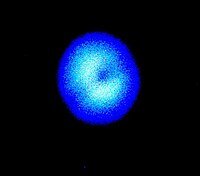Fresnel diffraction

Fresnel diffraction is like when you hold a toy car in front of a light and see how the light shines through the car. When light waves pass through a small opening or around an obstacle, they can bend and make patterns of light and dark spots. Imagine you are playing with a flashlight in a dark room and you make a shadow on the wall with your hand. You can see the shape of your hand, but also some lines around it that are lighter or darker. That is fresnel diffraction!
The bending of light waves depends on how far they travel and how much they are disturbed by the object they are passing through. Imagine you are playing with a toy boat in a pool and throw a rock in the water. The waves generated by the rock can move the boat up and down, but also change its direction. Similarly, waves of light that pass through an object can be deflected or refracted, making them interfere with each other in different ways.
When light waves interfere constructively, they add up and make bright spots. When they interfere destructively, they cancel out and make dark spots. The places where the light waves add up or cancel out create intricate patterns that scientists can use to study the properties of light and objects.
Fresnel diffraction can be seen in many phenomena, such as the colorful patterns made by soap bubbles or the rings around bright lights. It is a fascinating way to understand how light interacts with different materials and shapes, and how we can use this knowledge to create new technologies, from lenses to holograms!
The bending of light waves depends on how far they travel and how much they are disturbed by the object they are passing through. Imagine you are playing with a toy boat in a pool and throw a rock in the water. The waves generated by the rock can move the boat up and down, but also change its direction. Similarly, waves of light that pass through an object can be deflected or refracted, making them interfere with each other in different ways.
When light waves interfere constructively, they add up and make bright spots. When they interfere destructively, they cancel out and make dark spots. The places where the light waves add up or cancel out create intricate patterns that scientists can use to study the properties of light and objects.
Fresnel diffraction can be seen in many phenomena, such as the colorful patterns made by soap bubbles or the rings around bright lights. It is a fascinating way to understand how light interacts with different materials and shapes, and how we can use this knowledge to create new technologies, from lenses to holograms!
Related topics others have asked about:
